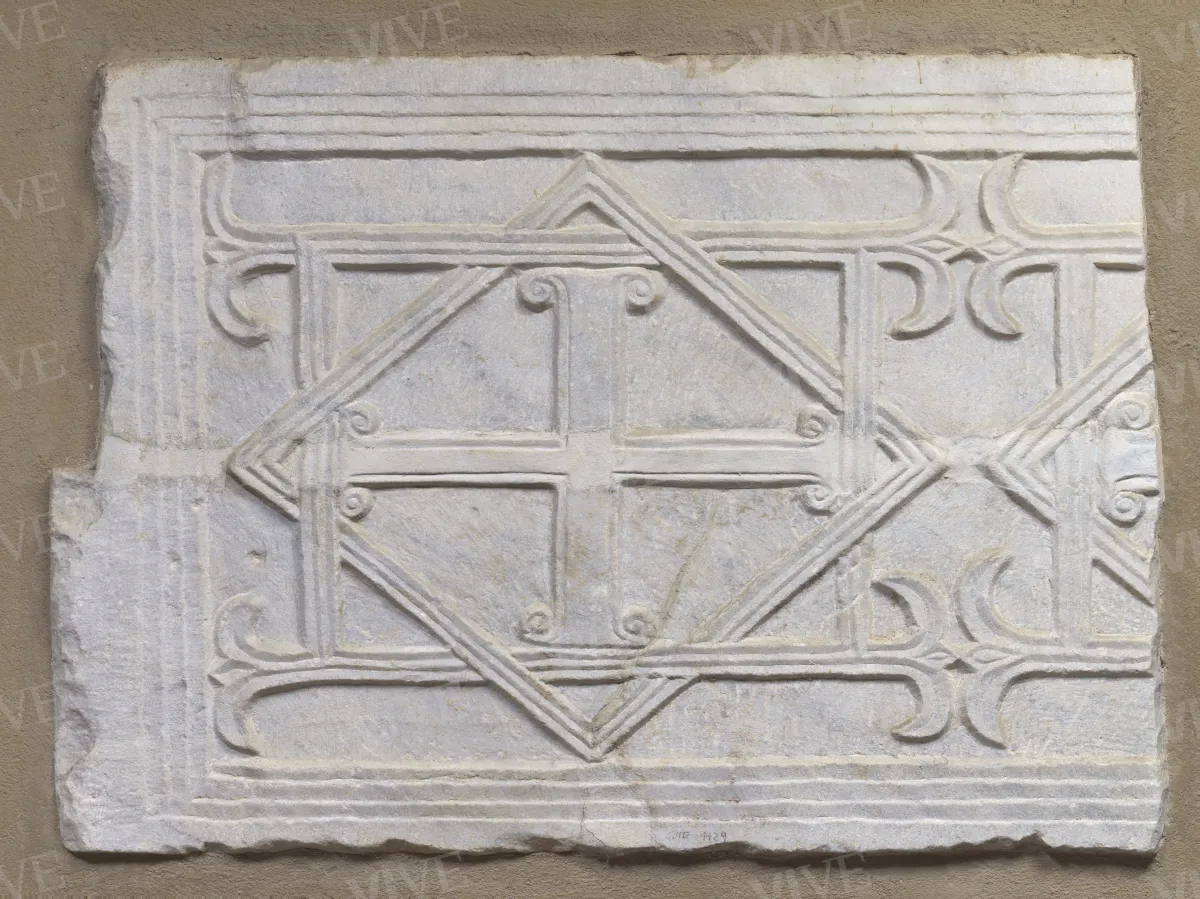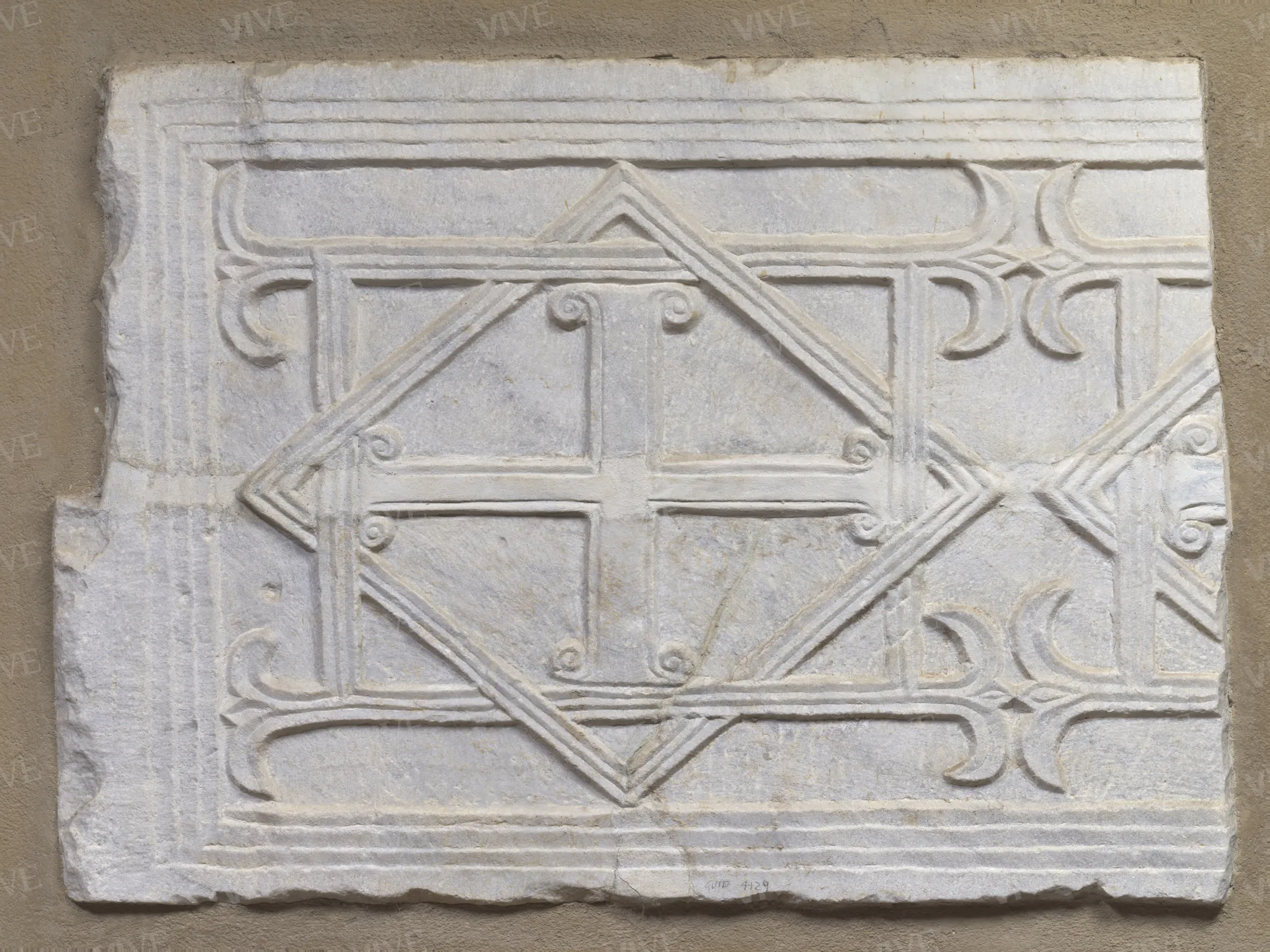Fragmentary pluteus with crosses inscribed in quadrilaterals
Roman milieu First quarter of 9th century
Fragmentary marble pluteus ornamented with a double Greek cross pattée motif with scroll terminations, inscribed in quadrilaterals of two-lined wicker ribbon, formed by a lozenge and rectangle intersected to form a star shape, with fleur-de-lis axially aligned with the horizontal sides of the rectangle, within a sawtooth frame.
Fragmentary marble pluteus ornamented with a double Greek cross pattée motif with scroll terminations, inscribed in quadrilaterals of two-lined wicker ribbon, formed by a lozenge and rectangle intersected to form a star shape, with fleur-de-lis axially aligned with the horizontal sides of the rectangle, within a sawtooth frame.
Details of work
Catalog entry
Within a smooth, uniformly mirrored structure bordered by a sawtooth frame is a ornamental geometric shape consisting of two quadrilaterals of two-lined wicker ribbon intersecting to form an eight-pointed star. Each quadrilateral is composed of a rectangle with fleur-de-lis apexes, arranged along an ideal axis with the horizontal sides, interlocking a lozenge spanned by a webbed engraved Greek cross pattée and scroll terminations. As seems to be suggested by the opposing lilies that join at the tip, an identical design was repeated on the right side of the pluteus that was later rather carefully cut away so that it could be repurposed.
The eight-pointed star motif, derived from the interweaving of two squares, dates to the Justinian Santa Sofia (Russo 1984; Barsanti, Guiglia Guidobaldi 1992) and features fleur-de-lis vertices as early as a slab from Saint Demetrius in Thessaloniki (Guiglia Guidobaldi 2002). It is recorded in Rome in the sixth century in the plutei of San Clemente (Russo 1984; Barsanti, Flaminio, and Guiglia 2015), albeit not of Roman production (Ballardini 2008), then in an unpublished redaction in the presbyterial enclosure of St. Peter’s in the Vatican, now in the Vatican Grottoes (id. figs. 18–21), dating to the first half of the eighth century.
The ornamental pattern is seen in early medieval Roman sculpture dating to the papacy of Leo III (795–816) (Kautzsch 1939, now Flaminio 2018 for occurrences) with a new note—the filled cross in the geometric pattern—and is associated with the iconographic repertoire of interlaced sculptural production, as part of the resumption of an early Christian “marker gene” from early ninth-century sculptural decorations in Rome (Ballardini 2008).
An ideal review of possible related examples would begin with the San Saba slabs (Trinci Cecchelli 1976, figs. 80-81) from the Leonian period, which already contain, within a pluteus with symmetrical double ornamentation, the two-line wicker line, terminal lilies, and cross with volutes; then there is the pluteus from Palazzo del Governo Vecchio (Flaminio 2018, fig. 2), dated to the turn of the papacies of Leo III (795–816) and Paschal I (817–824), and the small fragment from Santa Maria Maggiore (Pani Ermini 1974, fig. 51), part of the refurbishing of the church’s presbytery commissioned by Paschal I (817–824) in the early ninth century; we then find the version offered by the Paschalian plutei of Santa Prassede (Pani Ermini 1974, figs. 58–59 and 65). Here, although recourse to the early Christian and Byzantine model appears to be more rigorous, the co-presence of techniques, the widespread use of wicker ribbon, the sawtooth frame, and all those ornamental motifs that are shared by the craftsmen active in Rome in the early ninth-century sites combine with the stylistic features that became a mainstay of Roman sculptural production precisely with the papacy of Paschal I (817–824) (Seminario 1976, Betti 2017, Ballardini 2017), beginning with the essential purity of the geometric pattern, which is also obviously found in our fragment.
Moreover, comparison with the fragmentary pluteus from the Santi Quattro Coronati (Melucco Vaccaro 1974, fig. 158), dated to the time of Leo IV (847–855) and an example of a production characterized by “hasty execution” and “monotony of ornamental patterns” (Paroli 2001), seems to cover all the ground from prototype to its offshoots. In our pluteus, on the contrary, there is still a compositional conception that owes much of its specificity to the inclusion of the background plane in the ornamental motif and that contributes, together with the symmetry and geometrization of the embellishments, to an effect of formal elegance that can also be evinced from the fixtures of Santa Prassede e Santa Cecilia. In particular, in comparison with the Santa Prassede slabs, the relief appears flatter and the fleur-de-lis apexes hypertrophic compared to the measured geometric design of the main theme.
As in Santa Prassede, our pluteus’s repurposing resulted in the expurgation of the holy value of the cross; similarly, the length of the horizontal arm of the cross, which was already present in the Leonian pluteus from Porto (Macchiarella 1976, fig. 280; Episcopo 1982), is disproportionate. Our fragment is also markedly different from the latter fragment in its lack of the experimentalism that was often present in the age of Leo III (817–824) (Macchiarella 1976; Roperti 2007).
The slab, which has now been walled in, cannot be evaluated on the verso. However, it is likely to have shared a mesh-like decoration with a fragment of a two-faced pluteus (inv. 13602bis) now in the Palazzo Venezia Lapidarium.
Valentina Brancone
Entry published on 12 February 2025
State of conservation
Fair. Cropped along the right side, chipped along the margins with several nicks and an abrasion in the middle of the slab along the horizontal arm of the crosses, probably repurposed as flooring.
Restorations and analyses
1999 (cleaning).
Provenance
Unknown. Found during excavations for the Palazzetto, as part of demolition carried out in the area for the relocation of the Palazzetto di Venezia (1910–1914).
Sources and documents
Rome, Archivio del Museo del Palazzo di Venezia, inventorying the sculptures of the lower and upper loggias (manuscript inventory edited by Maria Vittoria Brugnoli, 1973);
Seminario sulla tecnica e il linguaggio della scultura a Roma tra VIII e IX secolo, in Atti del simposio su Roma e l'Età carolingia, coordinated by Avagnina Maria Elisa, Istituto di Archeologia e Storia dell'arte, Rome 1976.
References
Kautzsch Rudolf, Die römische Schmuckkunst in Stein vom 6. bis zum 10 Jahrhundert, in «Römisches Jahrbuch für Kunstgeschichte», III, 1939, pp. 3-73;
Melucco Vaccaro Alessandra, La Diocesi di Roma, t. III, La II regione ecclesiastica, Corpus della scultura altomedievale, VII, Spoleto 1974;
Pani Ermini Letizia, La Diocesi di Roma, t. I, La IV regione ecclesiastica, Corpus della scultura altomedievale, VII, Spoleto 1974;
Trinci Cecchelli Margherita, La Diocesi di Roma, t. IV, La I regione ecclesiastica, Corpus della scultura altomedievale, VII, Spoleto 1976;
Macchiarella Gianclaudio, Note sulla scultura in marmo a Roma tra VIII e IX secolo, in Roma e l’età carolingia. Atti delle giornate di studio (Roma, 3-8 maggio 1976), a cura dell’Istituto di Storia dell’Arte dell’Università di Roma, Roma 1976, pp. 289-299;
Macchiarella Gianclaudio et al., Seminario sulla tecnica e il linguaggio della scultura a Roma tra VIII e IX secolo, in Istituto di Storia dell’Arte dell’Università di Roma (a cura di), Roma e l’età carolingia. Atti delle giornate di studio (Roma, 3-8 maggio 1976), Roma 1976, pp. 267-288;
Episcopo Silvana, I rilievi altomedievali dell’area di S. Ippolito all’Isola Sacra. Problemi di stile e cronologia, in Atti del 5° Congresso Nazionale di Archeologia Cristiana (Torino, Valle di Susa, Cuneo, Asti, Valle d’Aosta, Novara, 22-29 settembre 1979), Roma 1982, pp. 539-549;
Russo Eugenio, Fasi e nodi della scultura a Roma nel VI e VII secolo, in «Mélanges de l’École française de Rome. Moyen-Age, Temps modernes», 96, 1984, pp. 7-48;
Barsanti Claudia, Guiglia Guidobaldi Alessandra, Gli elementi della recinzione liturgica ed altri frammenti minori della produzione scultorea protobizantina, in Guidobaldi Federico, Barsanti Claudia, Guiglia Guidobaldi Alessandra (a cura di), San Clemente. La scultura del VI secolo, con un catalogo delle sculture altomedievali, Roma 1992, pp. 67-270;
Paroli Lidia, La scultura a Roma tra il VI e il IX secolo, in Arena Maria Stella, Delogu Paolo, Paroli Linda et al. (a cura di), Roma dall’Antichità al Medioevo. Archeologia e storia nel Museo Romano Crypta Balbi, vol. I, Milano 2001, pp. 132-143, 487-493;
Guiglia Guidobaldi Alessandra, La scultura di arredo liturgico nelle chiese di Roma: il momento bizantino, in Guidobaldi Federico, Guiglia Guidobaldi Alessandra (a cura di), Ecclesiae urbis. Atti del Congresso internazionale di studi sulle chiese di Roma (IV-X secolo) (Roma, 4-10 settembre 2000), III, Città del Vaticano 2002, pp. 1479-1524;
Latini Massimo, Sculture altomedievali inedite del Museo Nazionale del Palazzo di Venezia in Roma, in «Rivista dell’Istituto Nazionale d’Archeologia e Storia dell’Arte», 57, 2003, pp. 113-152;
Roperti Antonella, Note sulla scultura, in Bonacasa Carra Rosa Maria, Vitale Emma (a cura di), La cristianizzazione in Italia tra Tardoantico ed Altomedioevo. Atti del IX Congresso Nazionale di Archeologia cristiana (Agrigento, 20-25 novembre 2004), Vol. I, Palermo 2007, pp. 411-420;
Latini Massimo, in Barberini Maria Giulia (a cura di), Tracce di pietra. La collezione dei marmi di Palazzo Venezia, Roma 2008, pp. 175-194, schede 1-29;
Ballardini Antonella, Scultura per l’arredo liturgico nella Roma di Pasquale I: tra modelli paleocristiani e Flechtwerk, in Quintavalle Arturo Carlo (a cura di), Medioevo: arte e storia, X Convegno internazionale di studi (Pavia, 18-22 settembre 2007), Milano-Parma 2008, pp. 225-246;
Barsanti Claudia, Flaminio Roberta, Guiglia Alessandra, La Diocesi di Roma. La III regione ecclesiastica, Corpus della scultura altomedievale, VII, 2 voll., Spoleto 2015;
Betti Fabio, L’arredo liturgico della Basilica di Santa Sabina al tempo di papa Eugenio II: dalla scoperta ai restauri storici (1894, 1918, 1936), in «Arte medievale», 7, 2017, pp. 31-52;
Ballardini Antonella, Scultura in pezzi: appunti sulla scultura altomedievale di Santa Prassede, in «Summa», 9, 2017, pp. 5-28;
Flaminio Roberta, Sulle tracce di un bassorilievo poco conosciuto: la lastra con le croci di Palazzo Nardini al Governo Vecchio (Roma), in Pedone Silvia, Paribeni Andrea (a cura di), «Di Bisanzio dirai ciò che è passato, ciò che passa e che sarà». Scritti in onore di Alessandra Guiglia, t. I, Roma 2018, pp. 299-317.












